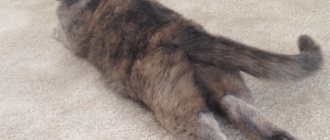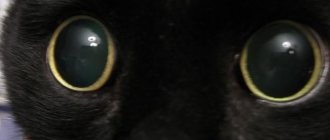If a cat's lower jaw is swollen, this may be a sign of traumatic injury, inflammation of the gums and lips, or neoplasm. The condition is accompanied by drooling, pain, and loss of appetite due to pain. At the first symptoms, you should take your pet to a veterinarian, who will determine the cause of the swelling and prescribe treatment.
According to veterinary oncologist A. Shimshirt, tumors of the lower jaw and oral cavity are more often diagnosed in older cats, which by the age of 10-12 years have chronic diseases.
Diseases of the teeth and oral cavity
If a cat's lower jaw is swollen, the likely cause is oral disease. In older cats we are talking about dental diseases. With age, teeth begin to loosen, lose hardness, and begin to crumble. Any microcracks in the enamel lead to the development of a pathological process, which results in complete decay of the tooth. In cats, the roots of the teeth are located deep in the gum tissue, so tooth decay can lead to the formation of a seal on the lower jaw. Associated symptoms:
- refusal to eat;
- jaw turned to one side;
- lethargy and weakness;
- no pain when pressed.
Typically, animals experiencing dental problems refuse to eat. At the same time, the cat experiences severe hunger and can in every possible way attract attention to its own bowl, but as soon as it is filled, the pet will turn away and leave. This is because chewing food causes pain.
The structure of the tumor will tell you about the possible causes. If a hard neoplasm is noticeable upon palpation, but the cat breaks out and does not allow itself to be touched, a cyst of the lower jaw is a possible cause. This neoplasm can be caused by dental diseases and is an overgrowth of bone tissue in the lower jaw.
If a soft and heterogeneous structure is noted upon palpation, the possible cause is an abscess, the development of which is due to the presence of pathogenic microorganisms in the oral cavity. This happens when pathogenic agents penetrate deeply into the root of the tooth. The abscess must be opened surgically, but there are cases when it breaks out on its own.
We recommend the article: Should I be alarmed if my cat constantly licks itself?
Diseases of the oral cavity and teeth in cats are indicated by foul breath, red gums and impaired jaw movement during eating. This pathology can only be treated surgically - it is necessary to remove rotten teeth, open an abscess or cyst. If the abscess has opened on its own, antiseptic treatment should be carried out several times a day to avoid secondary infection of the wound cavity. During surgical removal, the doctor must prescribe antibiotics to prevent infection of healthy oral tissues.
What are the causes of swelling?
Traumatic injuries
Cats love to rub their faces against various objects, leaving their marks on them. Therefore, your pet may accidentally get hurt or get a splinter. A foreign body provokes inflammation, which causes swelling. A pet can hit its face during outdoor games and a hematoma occurs, in which bleeding occurs under the skin. Symptoms:
- painful swelling;
- unexpressed asymmetry of the muzzle;
- bloody crust if the skin is damaged;
- purulent discharge when the inflammatory process was not detected in a timely manner and the wound became infected.
Gum inflammation
Gingivitis is accompanied by reddening of the gums and bad breath from the pet.
Gingivitis covers the teeth and mucous membranes, spreading to the ligaments and bone structures of the jaw. The main reasons for the development of the disease are a lack of vitamins A and C, the introduction of bones into the diet that injure the gums, the formation of tartar, severe viral diseases, and malocclusion when the teeth regularly damage the mucous membranes. Signs:
- profuse drooling;
- putrid odor from the mouth;
- redness and swelling;
- decreased appetite;
- loss of body weight.
Eosinophilic granuloma
Most often it occurs on the lips due to allergies of various etiologies. It appears as an ulcerative tumor or plaque and appears predominantly on one side of the muzzle. Unfavorable factors for the development of granuloma are helminthic infestation, skin parasites, food components, household chemicals, some types of indoor plants, fungus or mold in the room. Manifestation:
- the appearance of dense nodules and ulcers on the lip;
- swelling;
- absence of pain;
- decreased food and water intake, which causes the cat to lose weight and show signs of dehydration.
Odontogenic osteomyelitis
If the cat refuses to eat and looks lethargic, this indicates the development of the disease.
The causative agent is Staphylococcus aureus. Inflammation affects all bone structures and bone marrow of the lower jaw. The main factor in the development of osteomyelitis is considered to be advanced gingivitis, abscess, periodontal disease, wounds through which infection entered, and incorrectly performed dental procedures. In advanced cases, the cat will not live long. Symptoms:
- local and general hyperthermia;
- lethargy, refusal to play and eat;
- increased thirst;
- the appearance of a fistula on the jaw, from which pus is released;
- heart rhythm disturbance;
- enlargement of local lymph nodes;
- redness, swelling;
- the appearance of areas of necrosis.
Neoplasms
According to veterinarian statistics, tumors of the mandibular joint and oral structures in cats account for 10% of the total number of pathological formations.
A dangerous manifestation in an animal is a salivary gland cyst, as it can degenerate into oncology.
If your cat has a lump on his chin, it could be a benign or malignant tumor. Among non-oncological pathological formations, a cyst of the salivary glands - mucocele - is most often diagnosed. Due to injuries, a cavity is formed in which saliva accumulates. It is manifested by slight swelling, there is no pain. Mucocele is dangerous due to degeneration into cancer.
Among malignant neoplasms, the lower jaw is affected by sarcoma or squamous cell carcinoma, which are characterized by an aggressive course and rapid formation of metastases. Oncology occurs due to a failure of the cell cycle, when cells begin to rapidly divide and form a compaction. Most often, cancer is provoked by the owner’s smoking in the presence of a cat, decreased immunity, and chronic inflammation of the jaw bone. Cats with cancer live 3-12 months. A malignant tumor of the lower jaw manifests itself as follows:
- pronounced compaction that increases in size;
- salivation;
- the appearance of blood clots;
- sudden weight loss;
- strong pain;
- general deterioration of health.
Malignant and benign neoplasms
Malignant tumors in the mouth of animals are rare. However, if the jaw of a cat over 13 years of age is swollen, cancer can only be ruled out after a comprehensive examination of the animal.
There are usually no specific symptoms for jaw cancer. The animal may become lethargic and refuse to eat, but these same signs accompany an abscess and dental problems. To make an accurate diagnosis, it is necessary to take an X-ray of the jaw and take a blood test to identify the inflammatory process. If the presence of a tumor is confirmed, an operation is performed to remove it, followed by tissue examination. For malignant neoplasms, animals are prescribed a course of chemotherapy.
The danger of malignant neoplasms is that they are rarely accompanied by significant symptoms. A jaw tumor at the beginning of development manifests itself in the same way as dental problems, but can cost the cat his life.
With osteosarcoma and squamous cell carcinoma of the jaw, pain is pronounced. The animal cannot chew, drink water, and does not allow the affected area to be touched. In some cases, syringe feeding may be necessary. It is important not to try to treat your pet on your own, but to visit a doctor in a timely manner.
Diagnostics
If a cat has a swollen lower jaw, the veterinarian conducts a visual examination and, depending on the preliminary diagnosis, prescribes the following diagnostic procedures:
Diagnosis involves a number of procedures, including magnetic resonance imaging.
- radiography;
- CT or MRI;
- general and biochemical blood tests;
- biopsy;
- cytological examination.
The cat's jaw is swollen photo
How is the treatment carried out?
The treatment regimen is prescribed by a veterinarian; self-medication of the pet is prohibited. The doctor removes foreign bodies from the skin of the jaw by treating the wound with an antiseptic. If a cat has a swollen chin due to inflammation, antibiotics are used, which are prescribed individually, as well as drainage of the purulent cavity, novocaine blockade. For gingivitis, the oral cavity is treated with drugs such as Miramestin, Chlorhexidine, Dentadin, and Zubastik. Inflammation is relieved with herbal decoctions of chamomile, oregano, and strawberry leaves. If the mouth is swollen due to cancer, surgery is prescribed to remove the tumor. Surgery is required for osteomyelitis, when dead areas of bone and tissue are removed.
Lump on cat's neck due to thyroid gland
Finally, another explanation for why our cat has a lump on her neck could be an increase in the size of the thyroid gland, which is located in the neck and in some cases can be felt. This increase in volume usually occurs due to a benign tumor and consequently leads to excess secretion of thyroid hormones, which cause hyperthyroidism, which affects the entire body.
An affected cat will exhibit symptoms such as hyperactivity, increased hunger and thirst, but thinning, vomiting, poor hair coat, and other rather nonspecific symptoms. It can be detected with a hormonal test and treated with medications, surgery, or radioactive iodine.
Odontoma
It is a benign neoplasm of mixed origin, in which both epithelial and mesenchymal cells are fully differentiated. Typically, enamel and dentin in this case are distributed in a pathological manner. Odontoma is usually detected in young animals, and it can develop in any part of the dental arch. Complex odontoma is a disorganized amorphous volumetric formation of hard dental tissues that has no resemblance to normal dental tissue. Mixed complex odontoma consists of several small tooth-like structures. Both types of tumor are encapsulated and often associated with an unerupted tooth. They are benign in nature, but can cause tooth decay and sometimes spread very actively.
Diagnosis and treatment of neoplasms
Diagnosis is carried out when any neoplasm appears. After a thorough examination, the doctor determines the level of danger of the resulting compaction and selects the appropriate therapy.
In addition to a clinical examination and history taking, it is necessary to check the functionality of the heart, study a general analysis of urine and blood, and also do a bacteriological analysis of the contents of the lump-vesicle. Using ultrasound and x-rays, the doctor determines the depth, exact location and size of the tumor. At an early stage, cancer is often asymptomatic, so biopsy and endoscopy are used to detect it.
The location of oncology development directly depends on the sex of the animal. Cancer in cats most often affects the testes, and in cats - milk bags. If the disease is detected at an early stage, therapy is reduced to taking special medications and gives positive results. At later stages the prognosis is negative. The patient is given painkillers and euthanized.
Table of primary and additional therapy
Drug or surgical therapy depends on the diagnosis, the state of immunity and the stage of development of the disease. Recommended treatment methods can be found in the example table.
| Type of pathology | Therapy | |
| Main | Additional | |
| Lipoma | Surgical excision of large lumps | Lipomas located near the spinal column or neck are not recommended to be touched. Intervention is allowed only if the lipoma is growing steadily |
| Hemangioma | Non-interference and surveillance | Complete surgical removal on an individual basis |
| Adenoma | Subcutaneous and intramuscular injections of antibiotics, antiviral and antifungal drugs | Surgery for increasing size |
| Mastitis | The animal is given a novocaine blockade, physiotherapy, a course of antibiotics and compresses are prescribed. | In advanced forms, surgical intervention is used |
| Cancer | In addition to special medications, the doctor prescribes radiation or chemotherapy followed by removal of the tumor | In later stages, pain management is used and euthanasia is recommended. |
| Abscess | An autopsy is performed and pus is removed using antiseptics. The treated area is isolated with a sterile bandage. Any remaining infection is treated with a course of antibiotics. | Long-term use of antibiotics is dangerous for the developing organism of kittens. If the animal is less than 1 year old, the veterinarian tries to reduce the recommended duration of antibiotic therapy as much as possible. |
| Cyst | For small formations, observation is recommended; for large ones, removal | Sometimes parasites are found in the growths. In this case, surgery is necessary even for a small cyst |
| Hernia | To remove a hernial lump, massage sessions are prescribed, the prolapsed organ is put back in place | For large formations, the doctor performs surgery to stitch the diverging ring |
| Inflammation of the paraanal glands | The accumulated fluid is squeezed out, facilitating the production of secretions | If pain occurs, the animal is injected with novocaine. If a predisposition to inflammation is identified, the cat will have to be taken for the procedure several times a year. |
| Eosinophilic granuloma | Based on the cause of the pathology, the cat is prescribed antibiotics, antihistamines or steroids. | A large weeping wound is usually excised to preserve the appearance of the affected area |
| Lymphadenitis | The disease is not independent and occurs against the background of another pathology. Painkillers, anti-inflammatory and antibacterial drugs are used for treatment | A large number of inflamed lymph nodes indicates leukemia. This pathology is not fatal, but requires long-term drug treatment |
Syringoepithelioma is not considered dangerous to health, so treatment is not provided. Hematomas resulting from minor injuries usually go away on their own or are eliminated with healing ointments.
In addition to traditional scalpel work, surgeons use laser excision, electric shock, or freezing at low temperatures with liquid nitrogen. Young and healthy animals with strong immunity often heal on their own. In this case, they receive immunity, eliminating subsequent relapses.
After surgery, the animal is prescribed a course of immunomodulators that stimulate the functioning of immune cells. The remaining wound is treated with healing ointments. Bandages can be changed yourself or at a veterinary clinic. Be sure to consult a doctor if pus continues to leak from the bandage after surgery. Some tumors found in cats are dangerous not only for animals, but also for humans.
What to do with purulent and bleeding seals?
The appearance of bleeding and purulent discharge is a symptom of cancer. Immediately upon discovering a problem, take your pet to see a veterinarian.
Before visiting a doctor, it is prohibited to treat wounds with alcohol-containing solutions, squeeze out or puncture the lump. It is also not allowed to use any ointments without prior consultation. Even plain water can make the situation worse, so do not try to rinse or wet the swelling.
If the seal breaks on its own, provide first aid to the animal. To do this, you need to treat the wound with an alcohol-free antiseptic and apply a sterile bandage. All these actions do not exclude a veterinary examination.
Oncological formations
Oral cancer is a rare occurrence. According to statistics, in three cats out of a hundred, cancer causes the formation of a malignant lump in the area where the whiskers grow. Therefore, if you notice a tumor on the face, immediately contact a veterinary clinic.
The cause of a malignant tumor can be a pet’s poor diet, based only on canned food. Smoking by the owner in the presence of the animal. Most often, squamous cell carcinoma or fibrosarcoma . Cancer treatment is carried out outside the home. The sooner the owner contacts the clinic for a diagnosis, the greater the animal’s chances of survival. As a rule, surgical removal of a tumor on the cheek is prescribed. To prevent metastases from appearing, doctors administer chemotherapy. But if the owner missed time, did not pay attention to the symptoms and started the disease, it will not be possible to cure the cancerous tumor.
Adamantinoma
It is a neoplasm of epithelial tissue, such as enamel, that has not differentiated to the extent that enamel can form. It develops either at the gingival margin (peripheral ameloblastoma, manifested by epulis) or from within the bone (central ameloblastoma). Some of the central ameloblastomas appear as cystic lesions within the bone. Although biologically this tumor is benign and does not metastasize, locally it is extremely infiltrative and aggressive, causing extensive bone resorption, tooth displacement and even resorption of tooth roots.
In conclusion
Acne in a cat can occur regardless of age, gender, weight, breed, etc. Skin disease in animals, according to reviews from breeders and doctors, is one of the most common. It should also be noted that in some cats, acne and blackheads on the chin go away on their own, only occasionally appearing in small quantities. In this case, even the owners do not always detect the problem, which can be resolved without outside intervention.
It is not difficult to cure this skin disease in a cat. The main thing is not to self-medicate, observe hygiene requirements and provide the animal with balanced nutrition.
Symptoms of acne in cats on the chin
Many cats first develop a slightly dirty chin, covered in small black spots between the hair follicles. Sometimes, symptoms in cats are limited to just this manifestation. In other cases, it may begin to progress into swollen, red lumps that begin to rupture and bleed.
If the problem continues to progress, it is likely that the follicles may become infected with Staphylococcus aureus. This is a fairly common bacterial infection that can usually be found on the surface of the skin. This complication is called bacterial folliculitis. This serious skin infection requires more aggressive treatment. Folliculitis can also lead to secondary fungal infections if not treated properly.
Causes of subcutaneous lumps
Small round balls often appear after injection under the skin. They are called post-injection granuloma and resolve on their own a few days after the end of the injections. To avoid them, the injection site is massaged daily. Sometimes granulomas remain for life, without changing their size and position. In other cases, the reason lies in:
- blockage of the sebaceous glands;
- allergic reaction;
- infestation with parasites;
- hormonal imbalances;
- infection of open wounds;
- disturbances in the formation or functioning of connective tissues;
- injuries;
- inflammatory processes.
The risk group includes older animals, cats with chronic diseases, late castrated and sterilized pets. The risk of developing cancer increases with constant stress, low activity and poor diet. A predisposition also appears with frequent injuries in the same area of the body, infection with leukemia and regular inhalation of tobacco smoke. Cancer is often inherited and is diagnosed in animals older than 7 years.
The cat has a bump on his face
Finally, once we've identified the most common reasons why a cat has a lump on its neck, we'll see why lumps can appear on their face as well. The cancer, squamous cell carcinoma, can cause nodular lesions, as well as the less common disease cryptococcosis.
Both require veterinary treatment. Cryptococcosis with antifungal drugs, as it is a disease caused by a fungus, and carcinoma can be operated on. As we can see, it is very important to contact a veterinarian as soon as possible in order to begin treatment as early as possible to avoid complications.











